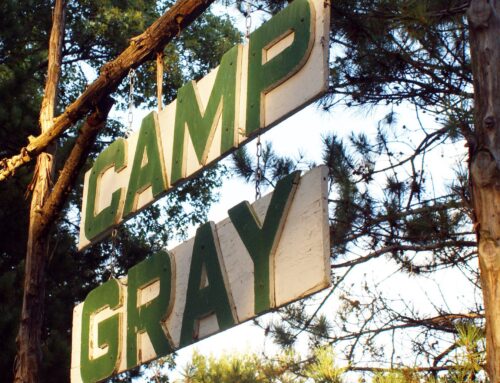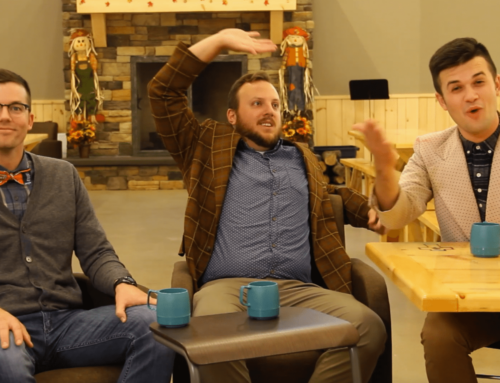By: Chris “Topher” Aderhold
Without Monsignor Gray’s dream, there wouldn’t be a Camp Gray. His dream, 62 years ago, was to create a safe place where young people could have loads of fun, grow deeper in their Catholic faith, and make life-long friends.
Without the vision and dedication of John Karsten and Monsignor Larry Bakke, Monsignor Gray’s dream might have ceased to exist.
For the past 30+ years, Karsten and Bakke have played an enormous role in shaping the growth of Camp Gray. They have steered Camp Gray from near-oblivion into one of America’s premiere Catholic Camps. Last Friday, I had the great honor and privilege of sitting down to lunch with them.
On November 12th, Karsten is being honored at the annual Catholic Charities Dinner in Madison. He is receiving their Leadership Award, which is given annually to a person that has served the community to ensure a better future for the lives of many. He is receiving the award in large part because of the time, energy, and leadership he has given to Camp Gray over his many years of service.
A few weeks back, I emailed Karsten to ask him if we could meet for lunch. “I’d like to write a story about your involvement at Camp Gray,” I told him, “especially in light of soon receiving the Catholic Charities Leadership Award.” He agreed to meet, and suggested that we invite Monsignor Bakke, as well. This, it turns out, was an excellent idea.
The three of us met at Sprecher’s in Madison, and for more than an hour we talked – well, they talked, and I listened, which is exactly what I hoped for. It was story time, and I had the great gift of a front row seat.
The story begins way back in 1979 – the year Father Larry Bakke became Camp’s Director. When Bakke was first assigned to be Camp’s Director, he also served as the Youth Director of the Diocese of Madison. A few years later, he continued to direct Camp Gray, but he was reassigned from Diocesan Youth Director to Associate Pastor at St. Albert the Great Parish in Sun Prairie.
Early on during his time at St. Al’s, he met a young engineer – a father of three – who had worked his way up the ladder at a large-scale Madison construction company. His name was John Karsten, and Bakke was immediately impressed with John and his wife Diane’s involvement at the parish.
The year was 1985, and Karsten was just the kind of smart, hard-working, passionate guy Bakke was looking for to be a part of Camp’s board of directors.
Camp Gray in the late-70s through the mid-80s was a different place than it is now. While money is always tight at a non-profit like Camp Gray, it was never as tight as it was in those years. Things we might take for granted now, Camp Gray lacked during those early years.
Remembered Bakke, “There was a great feeling of success when we finally bought a lawn mower for Camp – before then we would just borrow mowers from people in town.”
As I ate my lunch and sipped my root beer, I listened in awe as 30+ years of Camp Gray history came to life in front of me. In what was a trend throughout by each of them, credit for the growth of Camp Gray was passed to the other, or to many others not present. The names of dozens of important key players were shared – one that came up multiple times was Ken Ballweg.
Shared Bakke, “When word got out in the fall of 1978 that I would soon be taking over Camp Gray, Ken Ballweg sent a check for $10,000, and in the spring he sent a crew to build a new backstop for the baseball diamond.”
The backstop at the time was decrepit chicken wire, so an improvement was needed. Even more necessary was the money to begin improving various other areas of Camp.
When Bakke first took the reigns in January of 1979, he received a letter from the state health department listing nearly a dozen required improvements. If the improvements weren’t completed by summer, the state would close Camp down.
One such improvement was adding bathrooms to the St. Vincent Retreat Center. When Vinnies was first built, in the place of the bathrooms that are there today, there was instead a large storage closet. Fr. Bakke went about tackling the list.
“People always wondered why the toilets and the sinks in that original Vinnies bathroom were colored champagne, avocado, and pink. Well, it’s because those toilets and sinks were free,” Bakke shared with a laugh.
With the help of many, especially Ballweg, Bakke completed the list and had a successful first summer at Camp Gray.
From the moment Bakke came to Camp Gray, he saw immense potential. At the time, Camp Gray was open for 7 or 8 weeks in the summer, and then sat empty and quiet for the remainder of the year.
He dreamed of growing Camp Gray into the full-force year-round retreat center that it is today. He began taking the steps necessary to improve Camp Gray, and appointing men like Ballweg and Karsten to Camp’s board of directors was instrumental in Camp’s growth. With Karsten on board, and his construction company in tow, improvements began taking place immediately.
Most every facility improvement since 1985 has Karsten’s fingerprints on it – especially the ones that involve excavation. Camp’s original rectangle swimming pool, built in 1987: Karsten. The basements, footings, and foundations of the Day House and Gorman House: Karsten. The amphitheatre: Karsten. The new swimming pool built in 2012: Karsten. When we built our new office and retreat space, knocking down the old retreat space and office were necessary: Karsten.
For those that have been to Camp Gray, you know that our beloved Lake Jake is fairly small. For those that were a part of Camp Gray before John Karsten, you might be rather impressed with our current body of water – it was Karsten’s crew that expanded the Lake in the late-90s, more than doubling its size.
“I’m still upset John didn’t let me operate the backhoe when we expanded the lake,” Bakke deadpanned.
“At least I let you sit in it for a picture!” Karsten responded with a chuckle.
In 2012, Camp’s new retreat space was named Karsten Hall to honor John and his wife Diane’s many years of support of Camp Gray.
I asked Karsten, “What was it that kept you involved with Camp Gray all these years?”
Without hesitation, he responded, “At Camp Gray, kids can be kids. Camp is a safe place where kids get to learn about God and experience nature – it doesn’t get much better than that. The more Diane and I learned about Camp and saw its fruits, the more involved we wanted to become.”
“In addition to all that, from the beginning, it’s been: If Fr. Larry is involved, I want to be involved. He’s really been the glue that has kept this thing together – it could have easily been dropped and forgotten. For almost 40 years, through many transitions, he’s been Camp’s rock.”
Bakke stepped down as Camp’s Director in 1993, but has served alongside Karsten on Camp’s board of directors ever since. A few years back, Camp’s outdoor chapel was named the Bakke Outdoor Chapel to honor his many years of support of Camp Gray.

Monsignor Larry Bakke, with Jeff Hoeben, at the recent vespers and investiture ceremony that named him a Monsignor.
Bakke responded, “I’ve always felt so grateful to be a part of Camp Gray. I can remember in the past, walking the trails, kicking up leaves, and thinking, ‘I can’t believe I get to be a part of this place.’”
He spoke of vivid memories of the tough place Camp was at in 1979, and the sense of pride he has now to be a part of something that has grown so much.
“Camp Gray is such a positive place for kids and young adults,” Bakke said.
Additionally, the opportunity to work with Karsten has played a role in keeping him involved all these years.
With our lunches completed and the table cleared, the conversation began to wind down. Fearing I might have forgotten a question, I looked down at my notes to ensure that I hadn’t missed anything. All of my prepared questions had been asked, but a new question came to mind.
The man sitting to my left has been a priest for 40-years, faithfully serving in various roles around the Diocese of Madison. The man sitting to my right is an incredibly successful engineer with a wonderfully supportive wife and family, which includes three kids and five grandkids. Karsten and Bakke deserve lots of credit for Camp’s growth over the past many years, but I was curious, what or who they give credit to for becoming the men that they are.
“John, you’ll be recognized in a couple weeks by Catholic Charities, and Father, you were recently honored with the title of Monsignor. Obviously you are two very successful people – not just with the work you’ve done with Camp Gray – but who you are as men. What or who do you attribute your success in life to?
The good Monsignor answered first. “For me, I’d credit two things. First, I’m always open to possibilities – I want to continue learning and I like looking at what is possible in whatever situation I’m in. Secondly, what feeds that is to be so grounded in my faith and my relationship with Jesus Christ – to trust that I’m being led by the Lord.”
Then John answered. “For me, it all starts with the example of my Dad. He was an extremely hard working individual. I saw that growing up – I saw his dedication – I really respected that. From that example I’ve tried to always live by this: work hard, respect others, and whenever you can help somebody – do that.”
He continued, “I really feel like God put me on earth to be a leader, and so that’s what I try to do. If I come to a challenge – it might seem like it’s insurmountable – it may seem impossible, but I sit down and start breaking it a part and attack it little by little and say, ‘We can do this.’”
There it was, and just like that, it all became perfectly clear. Together, they see possibility, they put their trust in the Lord, they work hard, they help others, and they attack even those challenges that may seem insurmountable. These are the attributes that shaped the character of these two great men, and it’s the attributes that made Camp Gray into the Camp that it is today. Together they kept Monsignor Gray’s dream from being forgotten. The growth of Camp Gray didn’t happen overnight and it didn’t happen without loads of hard work and dedication. The magic of today’s Camp Gray, with ‘Merica Monday and the Cassidy Games; CTF on the AF and fishing for Walter; Mass in the St. Francis of Assisi Chapel and hot afternoons in the Camp Gray pool – thousands of young people have been impacted because of the leadership of Karsten and Bakke.
For many people, including myself, Camp Gray has played an enormous role in shaping us into the people that we are today. For many people, including myself, it’s scary to think where we’d be without Camp Gray.
On behalf of Jeff and Rebecca, the entire Camp Gray Staff, and the thousands upon thousands of young people that have been impacted by the Camp Gray mission over the past many years, it truly is a great honor to pass along my most heart-felt thanks to John Karsten and Monsignor Bakke for their many years given to Camp Gray. Thanks. I doubt that they’ll truly know, on this side of eternity, the great impact of their work.
May the Lord continue to bless you both!
Peace!






